Castle of Platamonas
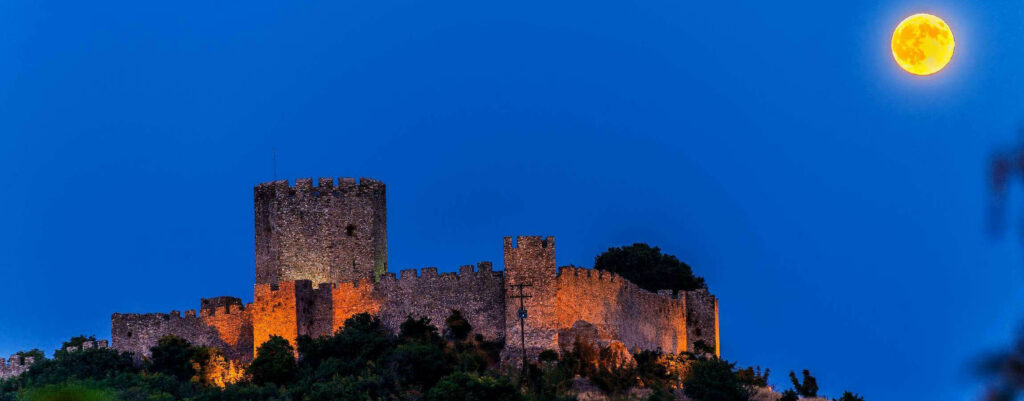
Platamon Castle, dating back to the mid-Byzantine period (10th century), was built over the grounds of the ancient city of Heraklion and was restored by the Franks after 1204, the Byzantines during the 14th century, and the Turks.
It is one of Greece’s best-preserved castles consisting of a defensive stone-wall and an octagonal fortress tower. Recent excavations have revealed a Byzantine church, dating between the 10th and the 11th century, houses belonging in the same period, an 18th century chapel, as well as storage spaces and a part of the wall from the Hellenistic period (2nd century B.C.)
Controlling the passages of Olympus towards southern Greece, Platamon Castle was targeted by many foreign conquerors, but, also, by Greek revolutionists during 1821. It is open to visitors during the hours provided for archaeological monuments. During summer, it hosts many of the events organized within the context of the Olympus Festival.
Waterfall “Kokkinos Vrahos” | Orlias
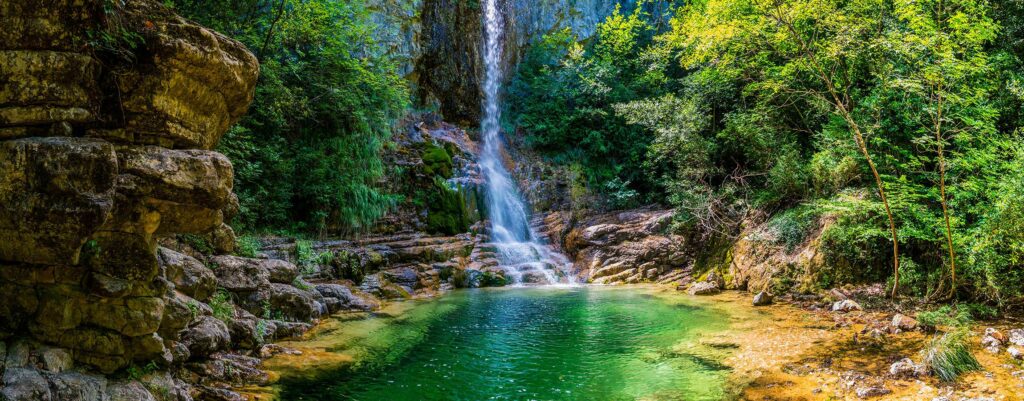
The streams running on the roots of mount Olympus create spectacular falls. In a distance of approximately 3 kilometers from the village of Karitsa, there is a beautiful worth-visiting spot, Agios Vassilios, surrounded by numerous plane trees. At 5kilometers from the village of Dion, the visitor comes across the location Agios Konstantinos from which one can also access the canyon of Ourlias where one can enjoy various mountain activities and take a cool break during the summer months. The location is one hour’s walk away from Dion archaeological area.
Enipeas waterfall
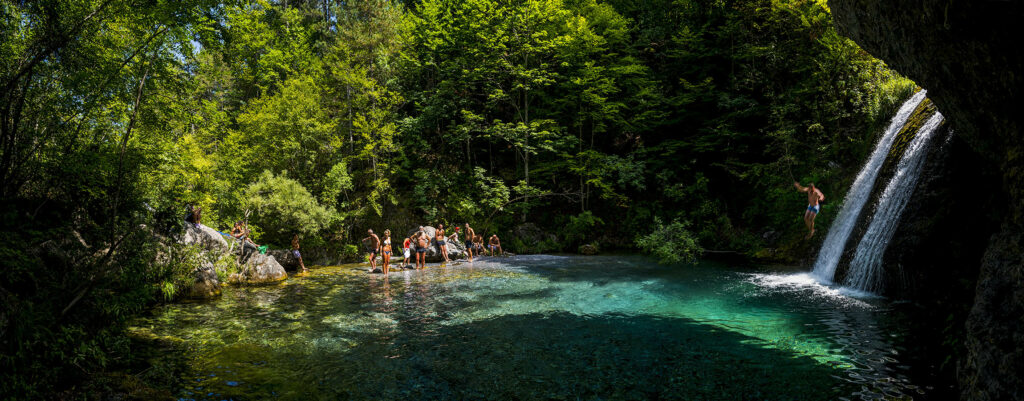
The canyon and waterfall of Enipeas is one of the most enchanting and popular trails of Mt. Olympus visitors. Both are easily accessible, either by embarking from “Myloi” in Litochoro, which is one of the entrance points to the Olympus National Park, or by driving to Prionia (1.100 m altitude) and continuing on foot back to Myloi. By following the course of Enipeas, the river is crossed a total of seven times over picturesque bridges and through lush vegetation. Small waterfalls, lagoons and gorges compose an ethereal landscape. The Old Monastery of Agios Dionysios leads to the magnificent Enipeas Waterfall, dropping from a 38 meter height into a mythical blue-green lake.
National Park of Olympus
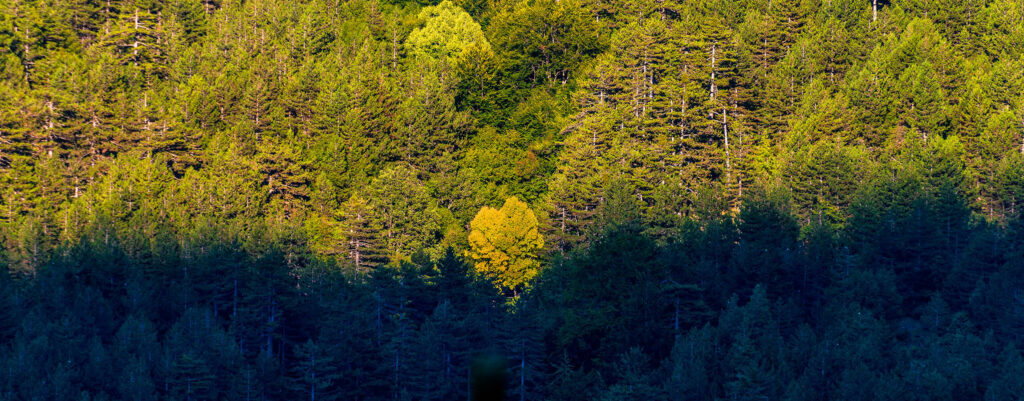
Beyond its mythological significance, Mt. Olympus is renowned for its fauna and flora biodiversity, since it is considered to be one of the top-ranking and rarest ecosystems on earth, which are under the protection of the international community. The Mt. Olympus National Park has a diversity of more than 1.800 species of plants, 23 of which – mainly flowers – cannot be found anywhere else in the world. There is also a wide range of fauna, however many of the mammals and birds of prey are presently categorized as endangered species. The global value of the natural heritage of Olympus has been acknowledged by UNESCO, which in 1981 incorporated it in the Biosphere World Reserves ecosystems, which belong to the world heritage. The European Union has also included Olympus in the “Most Important for its Bird-fauna Areas of the European Community”. The National Park of Olympus was the first to be established in Greece (1937) and is among the oldest national parks of the world. Its foundation aimed at the protection of the natural environment, the fauna and the flora of the Park from human interference. The core of the National Park covers an area of occupies an area of 44.500 1,000m2, on the eastern side of the mountain, enclosing Enipeas river and the gully of Mavrologgos, beginning at an altitude of 600m, reaching up to the Skolio – Mytikas – Stefani ridge.
The flora
Olympus has a great variety of flowers, bushes and trees dividing the mountain in three main zones that do not retain their uniformity since some trees and plants in other zones, thus, there is no clear classification of species according to altitude. In the lower one, at a height between 300- 700 m there are Mediterranean bushes [holm-oaks (quercus coccifera), arbutus (arbutus unedo), heathers (erica arborea), hazel-trees (corylus avellana), laurels (laurus nobilis), cedar-trees (juniperus oxycedrus), (paliurus spina)] deciduous and coniferous trees [hornbeans (caprinus betulus), ash trees (fraximus ornus), (cersis siliquastrum), cornel-trees (cornus mas), maple-trees (acer monspesulanum)]. Plane-trees (platanus orientalis) grow by the impenetrable gullies, poplar-trees (populus tremula), willow trees (salix caprea), linden trees (tilia tomentosa) and elm-trees (ulmus glabra), together with dense riverside vegetation. The second alpine zone, from 700 up to 2.400 m, is mainly covered by oaks(quercus frainetto ), beeches(fagus sylvatica), pine-trees(pinus negra), fir-trees(taxus baccata). There are big forests of olympic pine-trees (pinus heldreichii) and macedonian fir-trees (abies borisii-regis). In the last alpine zone, above 2400m, there are no forests except for some pine-trees, low bushes and several impressive and rare flowers, which only grow on Olympus, such as Cerastium Theofrasti (2500-2900m) and Festuca Olympica, which reaches up the peak of Mytikas. The southwestern side of the mountain, apart from some gullies, is bare, due to overgrazing, woodcutting and soil erosion.
The flowers of Olympus
The flowers of Olympus are world-renowned, the mountain being a favorite place of study for botanists from around the globe. The flowers of Olympus are identified by the international names, which are registered in the European Flora list (Flora Europaea). A registered sign of the mountain is a purple flower, Jankaea Heldreichii, which grows among the rocks and can only be found on Olympus. It was named after the pioneer German botanist Th. von Heldreich, who discovered several plants during his excursions on Olympus, in mid 19th century. Many of the mountain’s endemic flowers were “baptized” by researching botanists who chose places and mythological characters of Olympus, in order to emphasize their unique origin. As a result, wondering around on Olympus, especially early in the summer, one can meet Potentilla of the Gods (Potentilla Deorum), Dionysus` Silini (Silene Dionysii), Erussimo the Olympic (Erysimum Olympicum), Ligoustiko the Olympic (Ligusticum Olympicum), Veroniki the Thessalic (Veronica Thessalica), Centavria of Litochoron (Centaurea Litochorea), Poa the Thessalic (Poa Thessala) and others.
Birds and animals
Olympus’ fauna is rich, although the bears and deer, which existed in the past, have been gone and the few renowned royal eagles are endangered with extinction, birds which have been glorified by folklore music. Almost all the mammals of the Greek forests can be found on Olympus, such as wolves (canis lupus), boars (capreolus capreolus), jackals (canis aureus), wild goats (rupicarta rupicarta), foxes (vulpes vulpes), wild boars (sus scrofa), badgers (meles meles), ferrets (martes foina), weasels (mustela nivalis), hares (lepus europaeus), squirrels (sciurus vulgaris) and others. Several species of birds can be found on the slopes, the gullies and the clearings of Olympus. Birds of prey [golden eagles (aquila chrisaetos), royal eagles (hieraaetus pennatus), harrier eagles (gypaetus barbatus), vultures (gyps fulvus), peregrines (falco peregrinus), falcons (falconidae), falco biarmicus, buteo buteo, partridges, thrushes, cuckoos, horn-owls, bee-eaters, blackbirds (turdus merula), nightingales (luscinia megarynchos), orioles, woodpeckers (picidae), ravens (corvus corax) and others. All species of Mediterranean reptiles live on Olympus (snakes, lizards, tortoises), a great variety of insects and the famous butterflies of Olympus which are worth watching at early summer, close to the gullies. Fortunately, conservation measures have recently deterred the multinational collectors from catching the Olympic butterfly.
Dion archaeological park
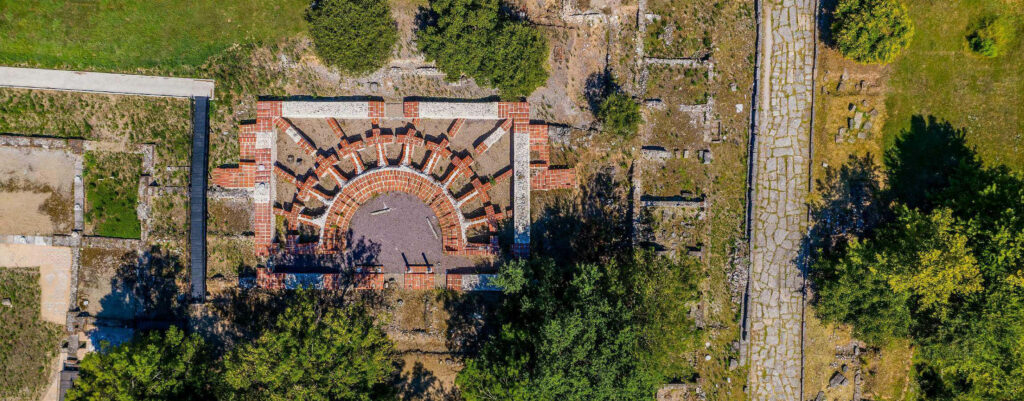
The archaeological site of Dion is one Greece’s most significant regions, as it is rich in antiquities, featuring streams gushing through ancient stones, a swift-water river Vafiras and lush vegetation with shady trees. A visit to the monumental ruins of Dion which belong to the Hellenistic,Roman and early Christian periods, is not only a visit to the historical past of a Macedonian city with an excellent, grid-like city plan of horizontal and vertical roads; it is also a trip of recreation through an archaeological park surrounded by natural beauty.
Cave Hermitage of Pythio
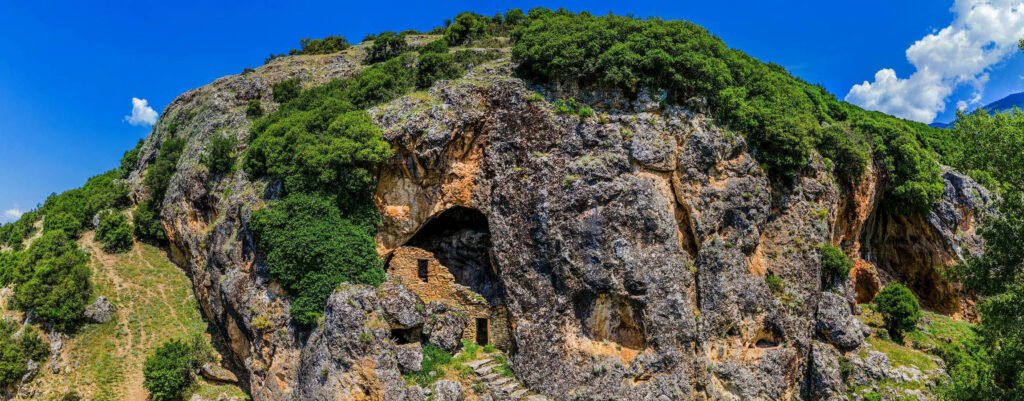
At the western plateaus of Olympus, close to Pithio village, two small chapels are preserved inside caves which were ascetic dwellings of anchorite monks. Murals dating back to the 14th century are still evident on the walls.